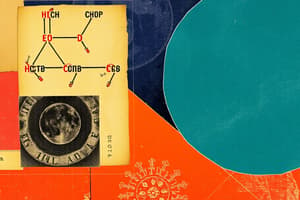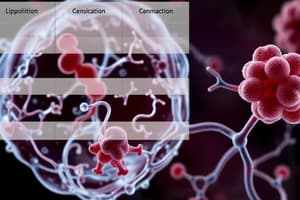Podcast
Questions and Answers
What is the functional group of alkenes?
What is the functional group of alkenes?
- Carbon-oxygen single bond
- Carbon-carbon double bond (correct)
- Carbon-nitrogen single bond
- Carbon-carbon triple bond
What is the simplest alkene?
What is the simplest alkene?
- Naloxone
- Ethyne
- Ethene (correct)
- Lidocaine
What is the functional group of esters?
What is the functional group of esters?
- Carbon-carbon double bond
- Carbon-nitrogen single bond
- Carbon-carbon triple bond
- Carbonyl group attached to an alkoxy group (correct)
What is the functional group of amides?
What is the functional group of amides?
What is the simplest alkyne?
What is the simplest alkyne?
What is the structural arrangement of carbon in a carbonyl group?
What is the structural arrangement of carbon in a carbonyl group?
Which of the following is a characteristic of the carbonyl group?
Which of the following is a characteristic of the carbonyl group?
What is the simplest alkane?
What is the simplest alkane?
What is a characteristic of alkanes?
What is a characteristic of alkanes?
Which functional groups contain a carbonyl group?
Which functional groups contain a carbonyl group?
What type of molecules do lipophilic functional groups tend to be drawn to?
What type of molecules do lipophilic functional groups tend to be drawn to?
What is a common characteristic of amines?
What is a common characteristic of amines?
What is the general formula for alcohols?
What is the general formula for alcohols?
What is a key feature of the hydroxyl group (-OH) in alcohols?
What is a key feature of the hydroxyl group (-OH) in alcohols?
What is a characteristic of amines that makes them important in pharmaceuticals?
What is a characteristic of amines that makes them important in pharmaceuticals?
What type of reaction is hydrolysis classified as in Phase I metabolism?
What type of reaction is hydrolysis classified as in Phase I metabolism?
What is the result of enzyme induction on the half-life of a drug?
What is the result of enzyme induction on the half-life of a drug?
What is the main purpose of Phase II metabolism?
What is the main purpose of Phase II metabolism?
What happens to orally given drugs in the first pass metabolism?
What happens to orally given drugs in the first pass metabolism?
What is the term for the attachment of a sugar group to a molecule in Phase II metabolism?
What is the term for the attachment of a sugar group to a molecule in Phase II metabolism?
What is the effect of hepatic disease on the clearance rate of drugs that are capacity-limited?
What is the effect of hepatic disease on the clearance rate of drugs that are capacity-limited?
What is the bioavailability of IV drugs by definition?
What is the bioavailability of IV drugs by definition?
What happens to enzymes when there is enzyme inhibition?
What happens to enzymes when there is enzyme inhibition?
What is the result of enzyme saturation on the metabolism of a drug?
What is the result of enzyme saturation on the metabolism of a drug?
Which phase of metabolism is responsible for making a drug more water-soluble?
Which phase of metabolism is responsible for making a drug more water-soluble?
Flashcards are hidden until you start studying
Study Notes
Functional Groups
- Lipophilic molecules are drawn to hydrocarbons and other non-water-soluble molecules.
Amines
- Amines are derivatives of ammonia (NH3) with the general formula NR3, NHR, NRR', and +NRR'R".
- All amines have a lone pair of electrons on the nitrogen atom.
- Amines can form hydrogen bonds and tend to be more soluble in water than many other functional classes.
- A large number of medications are amines.
- Amines have a noticeable base strength and will accept a proton from a strong acid to form its conjugate acid (an ammonium salt).
Alcohols
- Alcohols have the general formula ROH, where R represents any alkyl group.
- The hydroxyl group (-OH) of alcohols is highly polar and easily forms hydrogen bonds with other polar molecules.
Carbonyl Groups
- The carbonyl group (=O) is a key component of several functional groups: aldehydes, ketones, carboxylic acids, esters, and amides.
- The carbonyl group is polar, with the oxygen being more electrically negative.
- The carbonyl group is structurally identified as C=O.
Hydrocarbon Functional Groups
- Alkanes (C-C) are also known as paraffins and are the simplest of the organic compounds.
- Alkanes are characterized by carbon-carbon single bonds.
- Alkanes are the carbon backbone for other functional groups and are not water-soluble.
- Alkanes are hydrophobic (water-fearing) and lipophilic (lipid-loving).
Alkenes
- Alkenes have a carbon-carbon double bond functional group.
- The simplest alkene is ethene (ethylene).
- The location of the double bond is given by a locant number that identifies the first carbon in the double bond.
- The main functional group always gets the lowest number.
- Drugs that have alkenes include Naloxone and Vitamin K.
Alkynes
- Alkynes have a carbon-carbon triple bond functional group.
- The simplest alkyne is ethyne (acetylene).
- Alkynes are relatively rare in medical settings.
Amides
- Amides are similar to esters and have a carbonyl carbon atom singly bonded to a nitrogen atom.
- Examples of amides include PCN, LSD, and Lidocaine.
Esters
- Esters have a carbonyl group attached to an alkoxy group (single bond to an oxygen atom).
- Esters have increased lipophilicity, which increases the absorption of the drug.
Hepatic Clearance
- Hepatic clearance is the rate of hepatic metabolism by the liver, which is the difference between the drug concentration flowing into the liver and the drug concentration flowing out of the liver, multiplied by the rate of liver blood flow.
- Clearance is the amount of blood completely cleared of drug per unit time.
Phase II Enzymes
- Special consideration that affects metabolism is the difference between slow and fast acetylators (phase II reaction).
- Slow acetylators are more prone to toxicity with amides.
- Ethnicity affects acetylator phenotype:
- Caucasians: 50% fast acetylators
- African Americans: 50% slow acetylators
- Asians: 60-100% fast acetylators (e.g. Japanese: 80% fast acetylators)
Metabolism
- Phase I metabolism is enzymatic and can be saturated when too much or different drugs that use the same pathway are given in combination.
- The liver cannot remove every last drug molecule, and there is always some drug in the effluent plasma.
- The fraction of inflowing drug extracted by the liver is the extraction ratio.
CYP-450 System
- CYPs are a family of enzymes, with 50 types collectively known as the CYP-450 system.
- 6 enzymes (CYP1A2, 2C9, 2C19, 2D6, 3A4, and 3A5) metabolize 90% of drugs.
Metabolic Pathways
- There are 4 basic pathways of metabolism: phase 1 and phase 2 reactions.
- Phase 1 reactions include: oxidation, reduction, and hydrolysis, which increase the drug's polarity.
- Phase 2 reactions include conjugation, which increases solubility and renders the conjugate more water-soluble for subsequent excretion.
Sites of Metabolism
- Hepatic microsomal enzymes are responsible for the metabolism of most drugs.
- Other sites of drug metabolism include the plasma, lungs, kidneys, and gastrointestinal tract, and placenta.
Oxidation and Reduction
- Oxidation is the loss of electrons, loss of hydrogen atoms, or gain of oxygen atoms.
- Reduction is the gain of electrons, gain of hydrogen atoms, or loss of oxygen atoms.
- Oxidation and reduction are complementary processes.
Induction and Inhibition
- Some drugs can increase the amounts of available enzymes, known as induction, resulting in shorter half-life.
- Some drugs can inhibit these enzymes, resulting in prolongation of half-life.
Phase 2 Reactions
- Phase 2 reactions are synthetic reactions that attach polar molecules to the compounds being metabolized.
- Most drugs undergo phase 1 reactions and then phase 2 reactions.
- Common phase 2 reactions involve the attachment of a sugar group to the molecule, making it water-soluble.
First Pass Metabolism
- Orally given drugs are carried via portal vein circulation to the liver, where they get metabolized.
- The bioavailability of IV drugs is 1 by definition.
Extraction Ratio
- When clearance is flow limited, it is generally unaffected by modest changes in hepatic capacity.
- When clearance is capacity limited, changes in liver metabolic capacity produce nearly proportional changes in clearance rate.
Studying That Suits You
Use AI to generate personalized quizzes and flashcards to suit your learning preferences.




